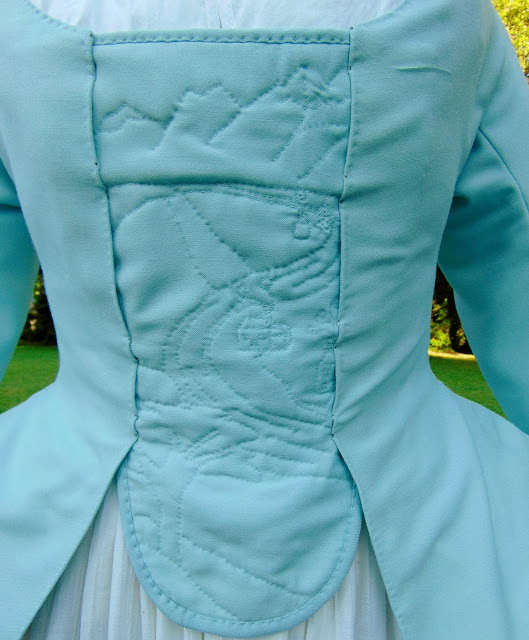Features: All visible stitching done by hand, including the petticoat hem and the quilting on the stomacher. The jacket has full edge stitching, also done by hand.
Measurements: *scaled up from the original piece by at least 5 dress sizes.
Chest: 43-45"
Waist: 36-38"
Back width: 15"
Hem: 40" at front
42" at back
44" at sides
~Making Lemonade~
First off, if you're familiar with the diagram XXX jacket in the Norah Waugh book, you're probably looking at the picture above and thinking, "Um...that's not that jacket." You would be correct. The front is entirely different because I screwed up royally when I cut my front pieces. I cut the straight center fronts over 2" to accommodate a larger size, but didn't extend that down to the "skirt" section of the bodice. That results was a straight, waist height front closure that really isn't accurate to the time period at all. Unfortunately, I didn't have enough wool left to re-cut the front pieces, so I had to slice them off and leave the front open for a stomacher.
The up side? I learned that the Waugh XXX jacket can easily be altered to a stomacher front! ;) hehehe
~The Original Pattern~
As stated above, the pattern is essentially the same except for the center front alterations I made. I also chose to not do the placket closure on the sleeves. The pattern is quite simple and has one horizontal seam on the side seam for fitting, as the jacket was cut to be worn over jutting pocket hoops.
I made general fitting alterations, of course, which included grading the pattern up by nearly 5 dress sizes, as well as lengthening the torso. If you plan to use this pattern, be cautious about the bust. At first it may seem that the neckline is too high, but really it's too BIG. The orginal garment was made for a rather well endowed woman, so the neckline is cut to "leaning out", which results in being too high if the wearing doesn't have the bust to accommodate.
I say this because you go to make neckline height alterations when that really isn't the problem, you will likely end up with a bust that is far too low. Instead, make your alterations at the sides by "lapping" or folding the pattern piece to bring the bust in.
~Stomacher~
Once I realized I had to go in a new direction because of my mistake, I was frustrated because I didn't want just a flat, plain stomacher. I couldn't do much heavy decoration or ruching, though, because I have yet to find any extant examples of such decoration being done with wool, or even on wool. Wool, it seems, was a casual fabric for ladies; no fuss, no muss. BUT, I did find numerous examples of quilted stomachers, usually done as elaborate white-work.
In keeping with the casual, working class feel I was going for with this one, I decided to do a "primitive" quilting scene on the stomacher. It features a landscape of a river valley with houses, and mountains in the background. In the foreground is a tree.
The stomacher is attached with pins, in the period appropriate fashion.
~Petticoat~
I'm actually kind of proud of this one, because it's the first pannier cut petticoat I've done that was drafted right on the form to get the "hang" just right. In the past, I've made petticoats by the cutting instructions featured in the JP Ryan patterns. While I like that method a lot, it does tend to result in a kind of "pouch" just as the skirt is creeping up over the pannier. The draping method takes longer, but is entirely worth it. =D
(below) the hem is stitched by hand =)
~Finished~
*Shown over pocket hoops and one thin under-petticoat.
The dress form is fitted out with stays and false bust pads.






















No comments:
Post a Comment